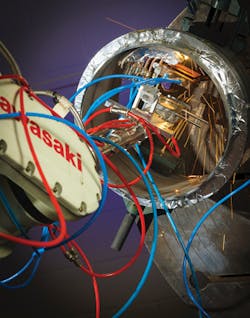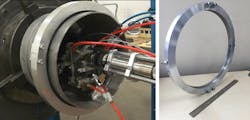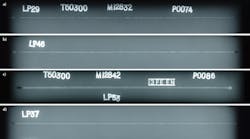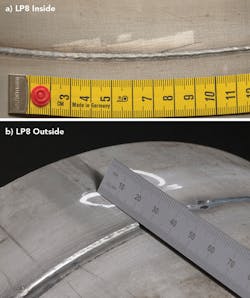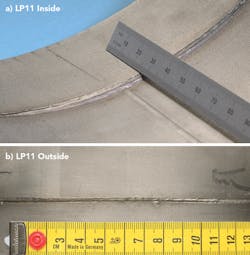Process has utility in nuclear plant pipeline maintenance
TONY K. PRAMANIK
The LaserPipe project involved two consortium partners, TWI and Oliver Crispin Robotics (OCR). The project was supported by the Innovate UK funding program, and focused on designing and developing a laser welding head suitable for in-bore, multi-positional laser welding.
A key project driver was to demonstrate an industrially viable and relatively cost-effective solution for nuclear sites where they perform regular maintenance to replace corroded or deteriorated pipes. Extensive plant shut-down times often occur, as there is much difficulty obtaining external access to the pipe for maintenance, or to manufacture new pipelines to replace corroded ones. The so-called LaserPipe method of welding can be applied to remote, in situ pipe manufacture and repair scenarios by carrying out laser welding in-bore. This was achieved by combining snake arm robots and fiber lasers to demonstrate reliable remote welding from inside a pipe, with the aim of reducing process cycle time to minimize plant shut-down time.
There are a number of challenges to overcome regarding autogenous laser welding in-bore. The majority of industrial laser welding processes are for the most part conducted in the down-facing (PA) position, but for multi-positional in-bore welding of a pipe, we must account for a number of new considerations:
- An increased need to control and minimize spatter and fumes in the confined environment;
- Ease of optical changeover in case of heat damage; and
- Achieving full-penetration keyhole welding, as this is the most effective means to complete a joint in one or as few passes as possible.
To understand the effect of gravity on the welding process, fluid and vapor flows in the weld pool and keyhole, respectively, as the rotating laser head propagates the weld from the PA position to vertical up-wall (PF), up-facing (PE), and finally down-wall (PG) positions.
Materials and equipment setup
Welding trials were conducted in-bore, using stainless steel pipes welded together in a butt-joint configuration. Pipes of two different dimensions were investigated for these trials:
- Outer diameter (OD) of 324.2mm, internal diameter (ID) of 315mm, and 4.6mm wall thickness; and
- OD of 273.4mm, ID of 265mm, and 4.2mm wall thickness.
These dimensions were chosen because they are standard pipe sizes that are readily available and low cost. The 4–4.6mm wall thicknesses are also relevant to pipes used in the nuclear industry.
The laser system used was a continuous-wave ytterbium fiber laser, with the beam delivered via an optical fiber to widely available off-the-shelf processing head components.
The optics setup was specifically designed to reflect the beam perpendicular to the welding head while making sure that off-the-shelf components could be used, maintaining a balanced tradeoff between desired performance, miniaturization, and relatively low equipment capital cost. All optics were housed in a novel laser welding head (FIGURE 1) purposefully designed and built for in-bore pipe welding.
An air-knife was used to protect the process head (particularly the optics) from spatter and fume produced during the experimental trials, and nitrogen shielding gas was used close to the workpiece because it has a relatively high solubility in stainless steels and is known from previous laser welding results to reduce weld metal porosity compared with argon or helium. The nitrogen gas shielding was provided to the inside of the weld via a panpipe configuration of four copper tubes immediately after the welding point. The root of the weld was shielded from atmospheric oxygen via a specially designed and manufactured stainless steel collar. The gas shielding collar featured gas inlet/outlet valves, hinged regions for pipe placement, and a machined channel for nitrogen to interact with the weld region. For the majority of trials, the laser welding process head was mounted onto a six-axis articulated arm robot. Different positions of the laser beam focal point were investigated.
The use of a high-resolution endoscope camera-based monitoring system ensured that the robot was programmed to target the region to be welded using the focused laser beam. Guide lasers, visible to the naked eye, were targeted to the joint line in all trials, and the high-power welding laser beam (infrared and therefore invisible to the naked eye) followed the same path as the guide lasers.
Three low-power pointing diodes were used to ensure that the focal point position was maintained during welding. Mounted in a triangular configuration, each diode was pointed at the calculated beam focal point position, resulting in a single spot being seen at focus.
Subsequently, should the image of the spots (on the material surface) diverge away from each other during programming, this indicated that the beam focus was not in the correct position with respect to the surface being welded, therefore requiring corrections to be made.
The weld parameters that were optimized in the tests included power and traverse speed. The gas shielding collar is shown in FIGURE 2.
Multi-positional in-bore pipe welding
The developed Welding Procedure Specification (WPS) produced high-quality, fully penetrating welds expected to meet the demands required by the nuclear industry. Specifically, welds were characterized by the following features:
- A consistent and crack-free weld top-surface;
- A wide weld width of approximately 4mm for improved tolerance to component fit-up;
- No discernible visual difference observed along the weld top-surface in terms of weld width, discoloration, or drop-through of material, as the weld position changed via rotation of the welding head—this could potentially be attributed to the relatively high viscosity of stainless steel compared to aluminum;
- The welds were shielded suitably from oxygen with the gas shielding setup, resulting in a bright silver weld appearance in all regions of the pipe;
- Radiographic analyses conducted in multiple positions concluded that there was no porosity in the through-thickness of the material from welding in-bore (FIGURE 3); and
- The weld quality was assessed against BS EN ISO 13919-1 and achieved, on average, a stringent quality level across the range of imperfections discussed in the standard.
FIGURE 4 shows an image of the top surface of a fully penetrating weld in-bore of the pipe, and also the root of the weld taken from the outside of the same pipe. The pipe had a wall thickness of 4.6mm. Because of pipe ovality, some high/low mismatch was present prior to welding. However, the laser welding parameters allowed consistent sealing of the weld seam via autogenous laser welding.
FIGURE 5 shows another fully penetrated pipe component, with a wall thickness of 4.2mm. Similar to the welded component shown in FIGURE 4, some ovality in the pipe caused high/low mismatch to be present along the weld seam. The same parameters as the sample in FIGURE 4 were used in this sample, demonstrating the repeatability of the parameters when pipe fit-up was not optimal.
Conclusions
The most significant conclusions from this work on multi-positional in-bore laser welding stainless steel were:
- No discernible visual difference in weld appearance was observed, such as weld width, discoloration, or drop-through of material as the weld position changes;
- The possibility that if a greater volume of molten material is required for full-penetration welding of thicker cross-sections, then weld appearance may vary as the weld positions change because of gravitational effects—a change in weld parameters, such as power and/or speed, may be necessary; and
- The joining of stainless steel pipes up to approximately 5mm in thickness can be achieved by multi-positional in-bore autogenous laser welding, which can significantly benefit the nuclear industry by minimizing plant shut-down time. The technology developed has the potential to solve the problems associated with gaining external access that is currently required for pipe manufacture/maintenance.
TONY K. PRAMANIK([email protected]) is project leader – laser and sheet processes in the Joining Technologies Group at TWI, Cambridge, Cambridgeshire, England; www.twi.co.uk/lasers.
